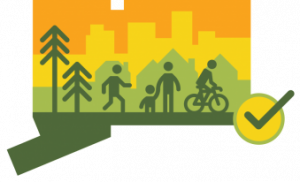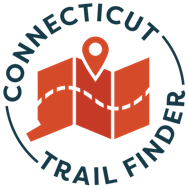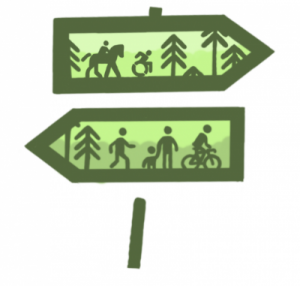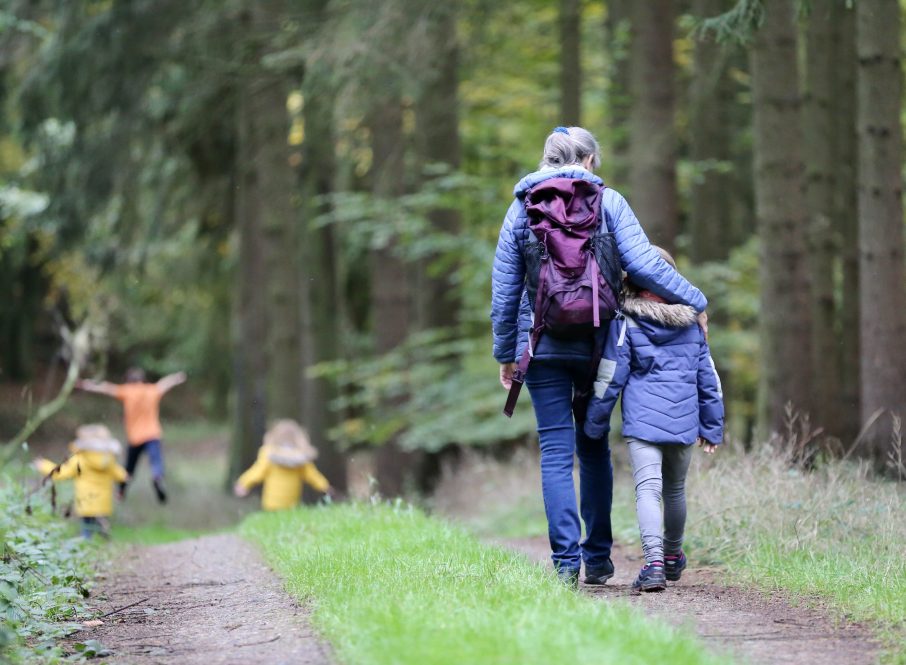According to the state Department of Energy and Environmental Protection (DEEP), there are more than 2,000 miles of multi-use trails within Connecticut’s state parks and forests — roughly the same mileage as hiking the Appalachian Trail end-to-end. A team from UConn Extension and the UConn College of Agriculture, Health and Natural Resources (CAHNR) is dedicated to ensuring that as many people as possible can experience the magic of these one-of-a-kind greenways.
The UConn CT Trails Program (“CT Trails”) was recently awarded two major grants from DEEP to expand its work with trail education, outreach, and research. The program’s co-leaders, Emily Wilson, Anita Morzillo, and Michael Puglisi are excited to use their outreach and research expertise and personal love of trails to bring the program into its next phase.
CT Trails encompasses three related projects: the Connecticut Trail Census, Connecticut Trail Finder, and People Active on Trails for Health and Sustainability (PATHS). With the new grant funds, each project is set to expand. This will provide Connecticut explorers with more information on the state’s bounty of off-road experiences and give urban planners, resource managers, and policymakers vital data about how these spaces are used.
Connecticut Trail Census 
Through a series of innovative data collection methods, including infrared sensors, the Connecticut Trail Census provides reliable information on trail use throughout the state. Researchers are able to see when trail use peaks, during a day or a season. The resulting reports can help land use officials understand the role that trails play in people’s lives across the state.
Several interesting trends have already been mapped by the Trail Census since its inception in 2017, including an overall spike in outdoor use during the height of the COVID-19 pandemic in 2020.
“It’s [currently] down from the COVID peak, as you would expect, but it’s still up from the pre-COVID times generally,” says Wilson, a geospatial educator within UConn’s Center for Land Use Education and Research (CLEAR).
The CT Trail Census was launched as a partnership between the Connecticut Greenways Council, Naugatuck Valley Council of Governments (NVCOG), UConn Extension and CLEAR, and CT DEEP.
The project organizers plan to use the new grant funding to build out an easy-to-navigate web dashboard of the census data.
Additionally, the team will explore alternative data collection methods, including results from a recent QR code survey pilot program.
“Essentially, this research is going to be looking into other ways to get at that information that could potentially be easier, and more synoptic and widespread,” Wilson says.
Connecticut Trail Finder 
A completely free, expert-designed website that is optimized for mobile devices, Trail Finder allows explorers to sort through Connecticut’s vast trail network to find an adventure that meets their needs in terms of distance, difficulty, accessibility, and even amenities. What sets it apart from crowd-sourced hiking apps is that every entry is reviewed by trails managers to ensure that only authorized trails and accurate information are included.
More than 1,000 miles of trails have already been catalogued, with more added to the site every day.
Up next, according to Wilson, will be an expanded network of trails and an emphasis on “trailside services.”
“It’s a module that’s going to include nearby ice cream shops, coffee shops, breweries, bike shops, libraries, and public transit near the trails,” she says. “So it really kind of gets at the community interaction with the trail resources we have here.”
And because no hike can feel truly complete without a Scouts-style badge to show for the effort, users will soon be able to collect badges on their profiles showcasing the trails they have visited.
PATHS 
The People Active on Trails for Health and Sustainability (PATHS) program evolved separately from the other two initiatives, according to Morzillo, but is now under the CT Trails umbrella and will benefit from the program’s research capabilities and grant funding.
“PATHS has largely been an Extension-led project,” says Morzillo, an associate professor in the department of natural resources and the environment. “Now we’re going to have a formally funded research piece in there. Hopefully, that’s just the start of lots of other good things.”
PATHS unites UConn Extension educators, faculty, and staff from across disciplines to promote the benefits of trail use through direct community outreach. These educators tackle the challenge using the lenses of public health, health education, nutrition, community development, and landscape architecture, to name a few.
The PATHS team hosts pop-up outdoor recreation days, networks between community members and leaders, and provides educational materials designed to encourage trail use. Informed by research and through community engagement, they seek to understand and respond to environmental concerns, opportunities and barriers to outdoor physical activity and recreation, and community health risks.
“Some of the power is that the research going on at UConn has a really clear path to get out to people who can use it and put it to work for their local decisions, whether they’re land owners or local policymakers,” Morzillo says.
All three initiatives under the CT Trails umbrella leverage the university’s outreach capacity in order to introduce people to the trails just beyond their doorsteps.
“People don’t tend to think of Connecticut as a destination to hike, right? People think of the White Mountains or wherever. But I think this work has really shown that Connecticut does have so many trails that are so attainable and close by. I think it’s created an awareness of this resource here that we have,” Wilson says.
“It’s a lot to map, I can tell you that,” she laughs.
On Oct. 13, 2023, CT Trails will host its fifth annual Connecticut Trail Symposium, with the theme “Connecting Connecticut,” where attendees can learn more about the significance of CT trails, with a keynote address from Joseph Dickerson, CT DEEP’s Senior Advisor for Outdoor Equity. In the days leading up to the symposium, participants can enjoy a film screening, visit some historical and entertaining attractions, and even take a guided hike through the birthplace of John Brown. For more information and to register, visit https://cttrails.uconn.edu/symposium/.



